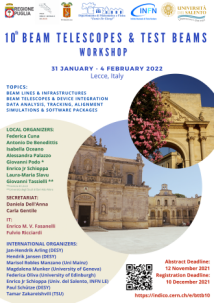Conveners
Experiments: Others
- Jan-Hendrik Arling (Deutsches Elektronen-Synchrotron (DESY))
Experiments: LHC I
- Nicola Minafra (The University of Kansas (US))
Experiments: LHC II
- There are no conveners in this block
The Extra Low Energy Antiproton (ELENA) is the new deceleration ring installed in the Antimatter Factory at CERN. Thanks to the introduction of ELENA, the antimatter experiments will receive an antiproton beam with an energy down to 100 keV, allowing improved performance and opening the door to new and exciting discoveries.
On the other hand, such a low energy beam required the development of...
Particle identification is one of the crucial and difficult task for the high energy physics experiments, like the future FCC-ee, CEPC, SCTF. The ionization of matter by charged particles is the primary mechanism used for particle identification (dE/dx), but the large uncertainties in the total energy deposition represent a limit to the particle separation capabilities. The cluster counting...
In this presentation we highlight the most significant outcomes from the systematic study of heavily Irradiated LGAD using the femtosecond laser test beam facility at ELI Beamlines. Instability and LGAD’s deaths associated to Single Event Burnout (SEB) from Highly Ionising Particles (HIP) are tested. Questions such as what the safe margin for operation is; is the sensor mortality a threshold...
The expected increase of the particle flux at the high luminosity phase of the LHC (HL-LHC) with instantaneous luminosities up to L ≃ 7.5×1034 cm−2 s-1 will have a severe impact on the ATLAS detector performance. The pile-up is expected to increase on average to 200 interactions per bunch crossing. The reconstruction and trigger performance for electrons, photons as well as jets and transverse...
The Phase-II upgrade of the LHC during Long Shutdown 3 (LS3) aims to reach a peak instantaneous luminosity of $7.5\times 10^{34}\mathrm{cm^{-2}s^{-1}}$, which corresponds to an average of about 200 inelastic proton-proton collisions per beam-crossing. To cope with these conditions, the ATLAS tracking system will be replaced by an all-silicon Inner Tracker (ITk). The ITk will be operational for...
In order to cope with the occupancy and radiation doses expected at the High-Luminosity LHC, the ATLAS experiment will replace its Inner Detector with an all-silicon Inner Tracker (ITk), containing pixel and strip subsystems. The strip subsystem will be built from modules, consisting of one n+-in-p silicon sensor, one or two PCB hybrids containing the front-end electronics, and one powerboard...
For the HL-LHC upgrade, the current tracking system of the ATLAS experiment will be replaced by an all-silicon system, called the Inner Tracker (ITk), consisting of an inner Pixel Detector and an outer Strip Detector.
The ITk Pixel Detector has two types of modules foreseen: triplet modules with 3D sensors in the innermost layer, and quad modules with planar sensors in the other...
The Large Hadron Collider (LHC) Phase II upgrade aims to increase the instantaneous accelerator luminosity.
A new readout system of the ATLAS Tile Calorimeter (TileCal) is needed to meet the trigger's requirements, to cope with the higher radiation levels and the ageing of the current electronics. It has to handle longer latencies of up to 35 µs at such high pileup levels.
Prototypes of the...
The Liquid Argon Calorimeters are employed by ATLAS for all electromagnetic calorimetry in the pseudo-rapidity region |η| < 3.2, and for hadronic and forward calorimetry in the region from |η| = 1.5 to |η| = 4.9. They also provide inputs to the first level of the ATLAS trigger. After successful period of data taking during the LHC Run-2 between 2015 and 2018 the ATLAS detector entered into the...
The FASER experiment at the LHC will be instrumented with a high precision W-Si preshower to identify and reconstruct electromagnetic showers produced by two O(TeV) photons at distances down to 200µm.
The new detector will feature a monolithic silicon ASIC with hexagonal pixels of 65 µm side, with extended dynamic range for the charge measurement and capability to store the charge information...
FASER, or the Forward Search Experiment, is a new experiment at CERN designed to complement the LHC's ongoing physics programme, extending its discovery potential to light and weakly-interacting particles that may be produced copiously at the LHC in the far-forward region. New particles targeted by FASER, such as long-lived dark photons or dark scalars, are characterised by a signature with...
The foreseen Large Hadron Collider upgrade is expected to deliver an integrated luminosity that is one order of magnitude larger after 2027. Rare processes and new phenomena may be observed in this high luminosity era. The Phase-II Outer Tracker upgrade of the CMS experiment is required to surmount higher radiation and increased event rate. Transverse momentum ($P_T$) discrimination is...
The High-Luminosity LHC (HL-LHC) will deliver proton-proton collisions at 5-7.5 times the nominal LHC luminosity, with an expected number of 140-200 pp-interactions per bunch crossing. To maintain the performance of muon triggering and reconstruction under high background radiation, the forward part of the Muon spectrometer of the CMS experiment will be upgraded with Gas Electron Multiplier...
Resistive Plate Chambers are operated in several experiments tipically with large fractions of Tetrafluoroethane (C2H2F4) commonly known as R134a, a gas with a high Global Warming Potential (GWP) that has been recently banned by the European Union.
Within the HEP Community, many studies are ongoing to find a good replacement for such component for RPCs working in avalanche mode. One...
A new era of hadron collisions will start around 2029 with the High-Luminosity LHC which will allow to collect ten times more data than what has been collected during 10 years of operation at LHC. This will be achieved by higher instantaneous luminosity at the price of higher number of collisions per bunch crossing.
In order to withstand the high expected radiation doses, the ATLAS Liquid...
